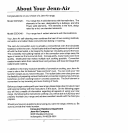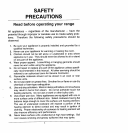
Improper Cookware
• Do not use cookware that extends more than 1 inch beyond the edge of the
element.
• Do not use a small cookpot on a large element. Not only can this cause the
elementtorequire moreenergyandtime, butit canalso resultinspillovers burning
onto the eJementwhich cause extra effort Jncleaning.
• Do not use nonflat specialty items that are oversized, uneven or do not meet
propercookware specifications such as round bottomwoks with rings, griddles,
rippled bottom canners, lobster pots, large pressure canners, etc.
Home Canning
Acceptable canning pots should not be oversized and must have a flat bottom. When
canners do notmeet these standards, the useof the HIheat setting becomes excessive
and may result in damage to the cooktop. Inaddition, water may notcome to a boil and
canners may not reach 10 lb. of pressure.
Theacceptable canning procedure uses theHIsettingjust longenough to bringthewater
to a boil, then lower the setting to maintain the water temperature.
Characteristics of Cookware Materials
Heavy gauge cookpots with flat, smooth bottoms will usually work in a similar way.
However, there are some differences in the cooking performance of various materials.
• Aluminumcookpotsheatquicklyandevenly. Bestsuitedforsimmering, braising,
boiling and frying.
• Stainless steel cookpots will evenly distribute heat if constructed of tri-ply or
combined with other metals such as aluminum and copper. Use for cooking
functions similar to aluminum.
• Cast iron cookpots are slow to heat butcook more evenly once temperature is
reached. Use for long term low heat cooking or for browning and frying.
• Glass ceramic, earthenware, heat-proof glass orglazedcookpots can be used
ifrecommended bythe manufacturer forcookpot cooking. Do notuse with trivets.
Best used on low to medium control settings.
• Porcelain enamel-on-steel or porcelain enamel-on-cast iron should be used
according to manufacturer's directions. Do not allow to boil dry.
11


















